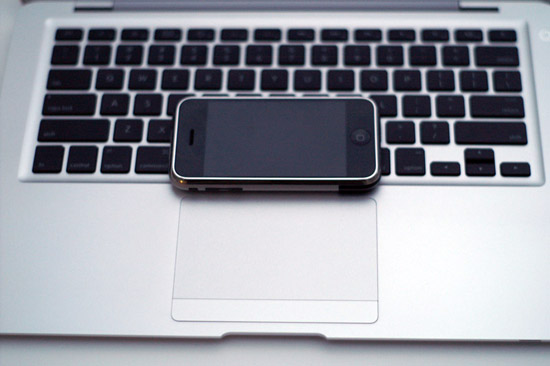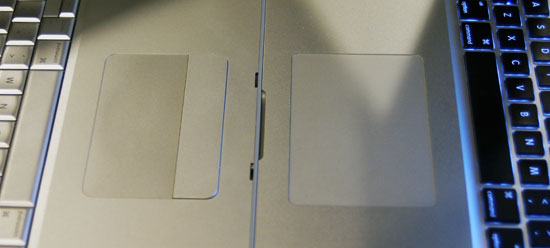Apple's Redesigned MacBook and MacBook Pro: Thoroughly Reviewed
by Anand Lal Shimpi on October 22, 2008 12:00 AM EST- Posted in
- Mac
Baby Steps: The New Trackpad
With the MacBook Air, Apple introduced its first oversized trackpad:

The MacBook Air's trackpad
The size was necessary to enable more complex gestures; you could now rotate pictures just using two fingers and the trackpad. Neat. The MacBook Pro got the same functionality with its update earlier this year, and now with this last redesign both the MacBook and MacBook Pro have support for even more gestures.

The old MBP trackpad (left) vs. the new MBP trackpad (right)
Slide four fingers from top to bottom and you'll activate Exposé, slide them from left to right and you can switch between apps. The gestures are nice but are still gimmicky in my opinion; they aren't integrated well enough into OS X as the OS wasn't designed with them in mind. The usage experience I'm looking for is more Star Trek tablet - or iPhone like if you want a more realistic reference. I think we're getting there, and Apple is planting the seeds for such a transition, especially if you look at the sort of trackpad used on the new notebooks.

The new trackpad lacks any discrete buttons; instead, the entire pad can be depressed and acts as a physical mouse button. Keep one finger on the pad and push down on it for a single click, have two fingers on the pad and it's a right click. Scrolling is the best implementation I've seen on a trackpad; just take two fingers and move them up/down/left/right to scroll.
The pad is also covered with a thin piece of glass that makes gliding your finger on it much smoother, which is admittedly very nice. None of this is necessary for the current gestures but it gives us a good indication of where Apple is going with this. It won't be this year, it may not even be next year, but real multi-touch is coming to OS X. Wake me up when that day comes, because until then this bandaid of gestures isn't going to win me over.
While I wasn't won over by the gestures, I would be fine with the new trackpad if it didn't have so many problems. I have had some issues with clicks not registering; I'm not sure if this is a hardware problem or a software one. The trackpad would physically click but the click wouldn't register in OS X. This problem appeared more on the MacBook Pro than the MacBook, and it didn't matter where I clicked on the pad, it just wouldn't register. Eventually it would sort itself out and everything would be back to normal. It seems like other users are running into this same problem and Apple appears to be replacing notebooks, but there's no indication that it's actually a hardware issue. I'd suspect it's a software problem but it's honestly too early to tell. So far it seems like if you take your finger off of the pad before you click, then put it back on to click you're more likely to make the click register. Or simply enable tap-to-click and you'll avoid the problems altogether - not a real solution in my opinion but a workaround.
The trackpad is even worse under Windows for some reason. If you try pushing down on the pad to make it click under Windows, the cursor has a tendency to jump while it is very well behaved under OS X. Again, I have a feeling this is more of a software problem but who knows if/when it will be fixed.
Hooray for being an early adopter of Apple's finicky product.










66 Comments
View All Comments
Johnmcl7 - Thursday, January 15, 2009 - link
I didn't say it was for *nix, that's why I said *nix applications which still use the middle mouse button in other operating systems. There are many times when there isn't space for using a mouse, hence it's a laptop.As for keyboard shortcuts, they're not faster when using a mouse as it means a break from the sequence rather than just clicking with the mouse that's in use anyway
themadmilkman - Wednesday, October 22, 2008 - link
Why don't you head to a store and try it? It's much more intuitive than you give it credit for.Sunrise089 - Wednesday, October 22, 2008 - link
There was a time when cars were changed and tweaked every single year, often for purely aesthetic/emotional reasons. That is no longer true. The average enthusiast car shopper is no less spec-conscious than PC geeks. And likewise the majority, and especially in the high-end/luxury market (Lexus, Apple) that is composed less by knowledgeable enthusiasts and more by people craving a certain image or experience, tend to shop based upon style, price, or other easy-to-understand factors.headbox - Saturday, October 25, 2008 - link
wrong. If people were "spec-conscious" about what they drive and getting performance was priority #1, then we'd see thousands of motorcycles on the freeways instead of dozens. You can spend $8,000 and get a motorcycle that is faster than any car made, gets 50 mpg, and can still carry a few bags of groceries.People buy nice cars because they can afford it and like the aesthetics.
RaynorWolfcastle - Wednesday, October 22, 2008 - link
Just a note, but I've read elsewhere that under Windows, the graphics on the MBP always use the 9600 chip; I'm sure this accounts for part of the difference in battery life (assuming you ran the OSX tests using the integrated 9400 video.ltcommanderdata - Wednesday, October 22, 2008 - link
The Windows vs OS X battery life tests were done on a MacBook Air so discrete GPU has no effect.jonmcc33 - Wednesday, October 22, 2008 - link
Maybe you should test the power settings with Vista on Power saver setting? My Latitude D610 lasts over 3 hours with Vista. I wouldn't use Balanced unless it was plugged into the AC adapter.Calin - Thursday, October 23, 2008 - link
What about testing under XP?jonmcc33 - Thursday, October 23, 2008 - link
Nobody cares about Windows XP and it would be REALLY bad to compare to the latest Mac OS X product.BushLin - Tuesday, October 28, 2008 - link
I don't see why, XP isn't a limitation on anything useful unless you were just talking about the eye candy of OS X... See how many businesses still supply their laptops with XP rather than the junk they're supplied with because they're not tethered to Microsoft like the manufacturers.